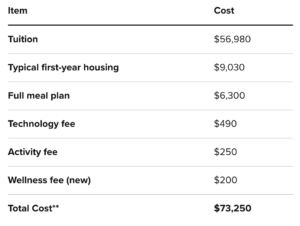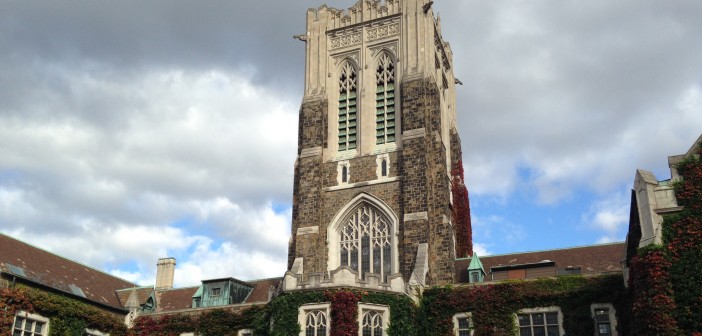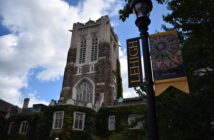The past year has seen consistently wavering action regarding Lehigh’s tuition changes. For the 2021-2022 academic year it was announced that there will be a four percent tuition increase as well as increasing additional costs for attendance.
Warren Loller, director of Lehigh’s Budget Office, described the changes as the craziest changes in tuition that he had seen since his arrival at Lehigh.
In March of 2021, the Board of Trustees approved a tuition increase of four percent to be implemented for the 2021-2022 academic year. This adds $2,190 to the previous price of $54,790, bringing annual tuition to a total of $56,980.
“They’re increasing tuition after a semester that’s been disappointing for Lehigh students, especially when compared to the experiences had at some of our peer institutions,” said Trevor Ballingall, ‘23, a member of the Student Senate. “We believe that the approved increase in tuition communicates a complete lack of compassion, and a complete disregard for the unprecedented circumstances that are impacting Lehigh families right now.”
The reason for the increase in tuition is to hire and retain faculty in a competitive market, said Pat Johnson, vice president for finance and administration. She said the largest percentage of the increase goes toward paying faculty. The other purposes are to make investments in the university itself, through things like programs or labs, and keeping up with changes in safety regulations.
“We’re trying to go back to where we should have been,” Johnson said.
In February of 2020, prior to the onslaught of changes that came with COVID-19, a tuition increase of four percent was also announced.
Due to COVID-19, the increase fell and tuition was instead frozen at the 2019-2020 price with a 10 percent discount offered to students who opted to be fully remote. The student activity fee for the fall semester was also waived.
“We really needed to realize that, going into the fall semester and it being so different, that increasing tuition, probably was not the best thing to do at that point,” Loller said.
In the fall semester, 42 percent of students opted for the fully-remote tuition cut.
In a year that was fiscally challenging for most, Lehigh was forced to cut costs too. They eliminated the match for pension, travel, merit increases in salaries and instituted a hiring freeze.
These decisions also had an impact on the university’s ability to distribute financial aid.
“Because we meet 100 percent of need, when we actually rolled back the tuition increase, we had to change aid packages because it was covered for a higher tuition,” said Jen Mertz, assistant vice provost of financial services and director of financial aid.
The lessened tuition this past academic year meant that fewer met the qualifications to receive aid.
“So we had to, in many cases, decrease financial aid awards, because they were over awarded,” Mertz said.
Along with the four percent increase in tuition for the 2021-2022 year, the cost of attending Lehigh is increasing through additional fees. There will be a new $200 wellness fee, a $20 increase in the technology fee, a $220 increase in board and a $370 room increase.
The tuition, combined with the additional expenses comes to approximately $73,250.

A breakdown of Lehigh’s total cost of attendance for the 2021-2022 academic year. (Courtesy of Lehigh University)
Need-based financial aid is planned to be adjusted to compensate for this increase.
“If you’re on financial aid that’s going to be lumped into the cost of attendance,” Mertz said. “So essentially if the fee is $200 your aid will go up $200.”
The new wellness fee being added, which in years prior has not been on the budget, will go to the renovation of the Health and Wellness Center, be used for additional testing and cover operational costs for keeping Trembly open as isolation housing, Johnson said.
“It’s going to be perceived as an additional cost, I’m hoping that they’ll see the outcomes and realize that it was money well spent for them,” Loller said. “I think once students realize that they’re getting some return on their investment for that, then they’ll feel a little bit more comfortable with having to pay that additional wellness fee.”
Other universities like Emory, University of Pennsylvania and Wake Forest also charge a wellness fee.
However, some current students are not in favor of the additional charge.
“For the university to charge students $200, they’re basically, in my opinion, putting a value on my mental health, they’re putting a price to my mental well being at Lehigh and to charge me, it almost feels like my mental health is a luxury that I need to be paying for,” Ballingall said.
The Student Senate has brought up some of these concerns to Johnson and the Board of Trustees.
“If the Student Senate is doing anything right now, it’s communicating the outcry of students to the Board of Trustees and Pat Johnson because I just don’t think they’re aware of how students are feeling right now,” Ballingall said.
The Student Senate has a scheduled meeting on April 19 with Johnson and Provost Nathan Urban to talk about the issue. They have also shared a survey to collect student, parent and alumni feedback on the increasing tuition.
“The financial anxieties that students are facing right now are not being adequately heard, or recognized or appreciated. So, the Senate is just working to give voices to those concerns, and express them directly,” Ballingall said.
He said the Student Senate will consider this first meeting successful by achieving primary objectives: establishing a more formal partnership between the Student Senate and the Board of Trustees that will carry on through future classes, improving visibility on what the school and the board are doing to mitigate tuition increases now and in the future, and a rollback of the proposed tuition increase until the economy and the families of the Lehigh student body have an opportunity to adequately recover from the financial impact of the pandemic.
“This entire thing could be avoided if there were checkpoints, like ways that the university can check in with student representatives about decisions that they’re thinking about making, because I think input is what is missing right now,” Ballingall said.






Comment policy
Comments posted to The Brown and White website are reviewed by a moderator before being approved. Incendiary speech or harassing language, including comments targeted at individuals, may be deemed unacceptable and not published. Spam and other soliciting will also be declined.
The Brown and White also reserves the right to not publish entirely anonymous comments.
2 Comments
Unlike public universities, private universities can’t increase taxes on the general population to cover increased costs. I would say quite a bit more is demanded of Lehigh, and sometimes provided, than in the past. Services have price tags.
Go to a public school. LU is not cost effective. For half the price go to Penn State, Pitt, UVA, UNC, VATech, Rutgers, NC State, GA Tech etc. And walk out w/o debt and having saved a bunch of $$$. If Lehigh realigned it’s budget, coursework, and payroll (teach vs admin) to look like 1990 LU would be cheaper, have happier students, rise in rankings.